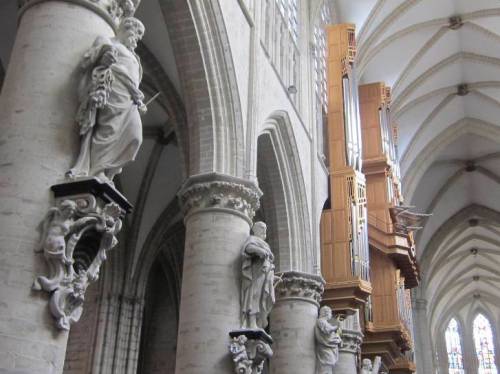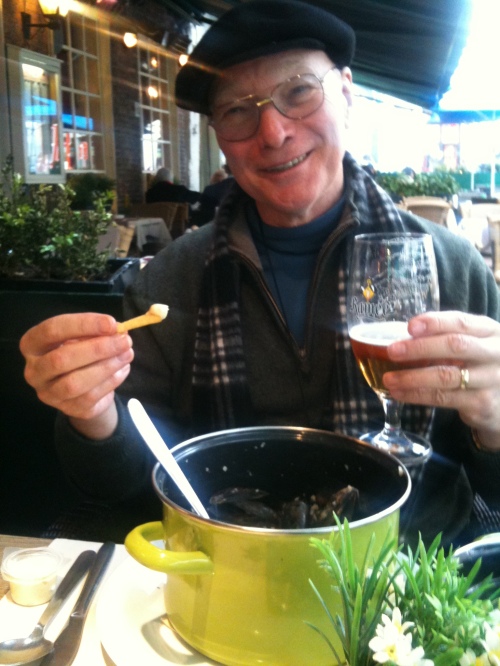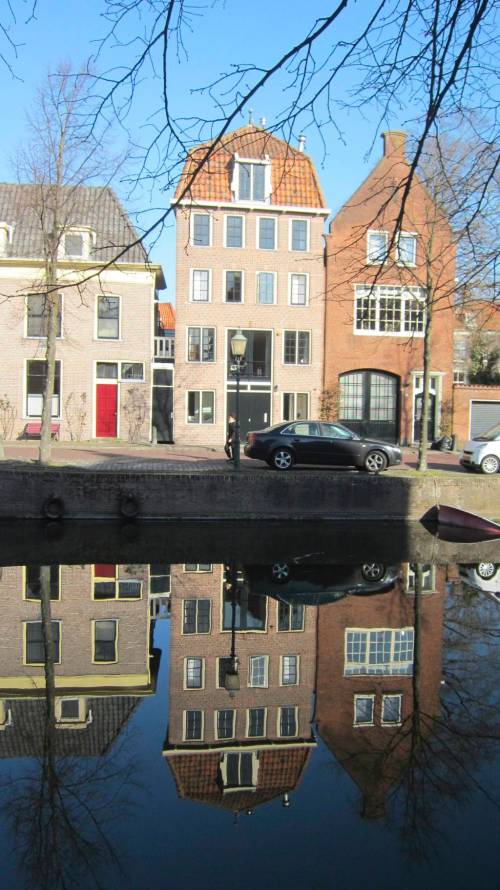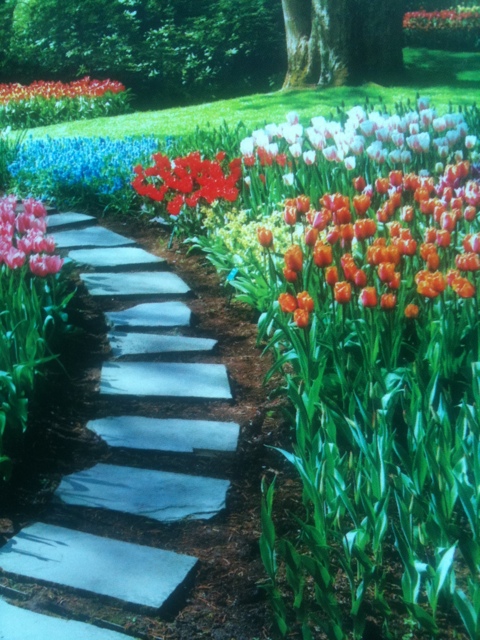Our last day in Europe, at least for this year. It has been a very special time. The best for me was all the museums and art. And for Wayne the cultural events and cathedrals were the most memorable. We both now know that we prefer the cities over the preserved towns such as Toledo and Prague. While those towns have marvelous architecture and interesting arts, they exist mainly on the tourist trade. As such, they are almost like Disney World with tacky trinket shops. The cities like Vienna and Berlin have all the arts and architecture but are vibrant and economically independent of the tourist trade.
We had almost a full day in Brussels. The flight home was at 5:25pm. So we returned to the Beaux Arts, this time to see the Magritte wing. There are only a few of his works I enjoy and one of them was there, The Dominion of Light. Most of his work I find flat and lacking light in the color. The surrealism subjects are funny to consider but his work does not move me. I was surprised to see works of his from a period when he emulated the Impressionists. I was also surprised to learn that his friends titled all his work.
We were unable to see any of the great Art Nouveau architecture. The most notable buildings were closed on Monday and in the opposite direction of the Museums.
We are now in the Brussels Airport. It will be a 12 hour trip.
Au Revoir Brussels
Posted in Uncategorized
Brussels, Grand Place
Brussels is a nice walking city. There are wide boulevards and sidewalks. It’s not terribly hilly either. Our hotel is about 1.5 miles from the museums and old part of the city. Since nearly all the museums are closed today, we walked to the Cathedrale des Sts-Michel-et-Gudule. I think it’s amusing that two saints have to share one cathedral. A gothic church begun in 1226, it only became a cathedral in 1961. Our friend Emperor Charles V donated the superb stained glass windows. That guy must have been trying to hedge his bets on heaven in a big way. Nearly every church we’ve been in has windows donated by him. The stone work is very white and many of the glass panes are clear. This makes for beautiful shadows and distinctive scroll work. This church also had an art show going. It seemed the works were somehow related to the cathedral, architectural drawings, religious scenes.
Next, we walked to an area called the Grand-Place. It is very appropriately named for it is very grand. There is a lot to take in when you first enter. It is a plaza of cobblestones surrounded by large public buildings dating mostly from the 1690s, but tbe town hall was built in the early 1400s. Ornamental gables, medieval banners and guilded facades in an array of architectural styles house restaurants, shops and government offices. This area is near the famous Mannique Pis (Pissing Boy). Of course we couldn’t miss this. It is much smaller than I knew. And he has hundreds of changing costumes. Today he was wearing a graduation outfit. The area was bustling. And there were waffle shops everywhere. Lunch time!
After overdosing on waffels with strawberries, cream and chocolate we headed to the hotel for a rest. That night we ate at a French/Belgium restaurant recommended by the concierge. Then back to the hotel to see a movie.
Posted in Uncategorized
Disembarkment and Brussels
We left the cruising world today. It was an easy exit. Our transportation to the Brussels airport was at 11:30 am, our kind of scheduling. We took the local train from the airport to Brussels and then a taxi to the hotel. The Central Train station was surrounded by a huge bazaar which seemed to be populated by hundreds of Arabs. Brussels is the capital of the European Union, and as such, as a very cosmopolitan atmosphere. But beyond politics it is also where Surrealism and Art Nouveau took root. Unknown to me, the city worships comic strips. Because we arrived on a Sunday, plan to leave on Tuesday, and nearly all the museums are closed on Monday, we immediately hit the road for the Royal Museums of Fine Art. The Museum is a complex that combines the Modern Art Museum and the Ancient Art Museum. Not knowing if we would have a chance to return, and having only about 3 hours before closing, we chose the Ancient collection. We knew there were Bruegels and Boschs there. And, of course a lot of Rubens, favorite son of Belgium. The Rubens room was a Wow experience. I’m not a huge fan but this room was impressive. The paintings were a good 30′ high. The color was high, the movement dynamic. The biggest surprise came on our way out (the closing announcement was being broadcast) when we scooted through some side galleries and stumbled upon David’s The Death of Marat. Oh, and a striking Lucas Cranach’s Adam and Eve. Just a magnificent museum. I’m so glad we rushed over.
We found a restaurant recommended on the NY Times site, Au Vieux Brussels, famous for its mussels. It was in a little old fashioned corner building and packed with locals. We knew it would be good. And it was. Mussels in a cream sauce with lard (bacon) and leaks. Add to that a bottle of Pinot Gris and a bowl of chips for a perfect Brussels evening.
Posted in Uncategorized
Antwerp
Antwerp is the diamond capital of the world (It’s definitely a place for you, Kathy.) and one of Europe’s largest ports. The old city is an easy walk from the ship, which we did with a local tour guide. We walked along the river past the Het Steen, an historic medieval fortress sitting on the edge of the river. From here we crossed over into the old center district to the “meat house”. It was built as the gild hall for the butchers. Every day tons of meat switched owners here. The building is famous for the original masonry and is made to resemble stacks of bacon (switching between white stones and red bricks). Near here, Old Market Square is the historical center of town. The market square is surrounded by medieval guild houses. Atop these houses are guilded sculptures of each guild’s icon. The city hall is designed in a combination between Gothic and early Renaissance styles. Our guide told us this style is almost exclusively found in this region of Europe. One street over is The Cathedral of Our Lady, a gothic church. It houses some of Rubens paintings. And, because the museum is closed, there were a number of paintings hanging from the arches and columns on deep red banners. These were paintings done for the guilds’ chapels in the Cathedral. Another small square adjacent to Market Square had a large sculpture of Rubens. It also has a series of beautiful buildings including a Hilton that occupies the former Grand Bazaar, a 19th century department store.
After our guide left us, we had lunch and shopped for chocolates. Then we returned to the Cathedral of Our Lady to rent the head sets and get a closer look.
Posted in Uncategorized
Bruges
We are docked in Antwerp. Thus far we have managed to avoid the norovirus, and could go today to see the beautiful medieval city of Bruges, which is the primary reason we took the cruise. We were bussed there. Bruges is a UNESCO World Heritage Site. During the Middle Ages Bruges was among the wealthiest cities of Europe. When the city lost access to the sea, it also lost its shipping industry and money. This was a blessing for those of us today. Completely ignored over the centuries, the city was not modernized and maintained its original medieval structures. We walked with a guide through parts of the city, then took a canal cruise in an open boat. This was a great way to appreciate the architecture. It reminded me of Venice, but in a cleaner way.
We were on our own in the afternoon. Our immediate goal was beer and mussels, which we found within 5 minutes. I had mine with white wine, Wayne with garlic. The garlic version was better. The beer is higher in alcohol and also much tastier. As far as frites go, we can’t notice any difference from those at a good clam shack. The city is just beautiful. If you are curious, rent the movie In Bruges. Ignore the plot and acting. But marvel at the setting of Bruges.
Neeltje Jans
We had a nighttime cruise and arrived in Veere this morning. They got us on the busses early for Neeltje Jans to visit the Delta Works. This is the system employed to control the flooding in The Netherlands. It is an engineering marvel. I thought Oleg would enjoy this very much. In 1953 a Northwest storm came on from the North Sea and broke through the dykes in several places. There was an immediate flooding of the area. Then with each subsequent tide, more dyke was eroded and greater flooding took place. Immediate restoration was needed It was decided to build more substantial dyke systems. I can’t go into the details, but there are a series of dykes that are open until the surge demand a closure. This system protects the wetlands from dying with a permanent closure. We walked through part of the dyke and to the top of one pillar. The power of the water was similar to Niagara Falls. And the wind blew me backwards. Impressive. It took almost 5 years for the salt to dissipate from the reclaimed land.
On our return we could walk the town of Veere. There were late Gothic houses built around 1540. Lots of antique shops and a market place were there.
Posted in Uncategorized
Kinderdijk and Rotterdam
There is an intestinal bug onboard. It’s not too widespread, but we will have no more buffets or open afternoon snacks. We have our fingers crossed to remain healthy because Bruges is in 2 days. The main purpose of this cruise is to see Bruges.
We are in Kinderdijk, home to more windmills than any other spot. It is a foggy morning which lends to the beauty; it is picturesque indeed! Last evening a local woman came onboard and explained the windmill, canal and land reclamation system. Today there are powered pumps to keep the reclaimed land (polders) dry. But it is mandated by law that the windmills remain in working order as backup emergency systems. People live in the windmills and the only charge is that they turn the windmill 60,000 times a year. We were able to tour an open mill. It’s tight living with 2 tiny rooms per floor. And steep ladders connect the 3 floors.
After Kenderdijk we sailed for Rotterdam. Here we had the choice to see Rotterdam on our own or take a tour to Delft and a Delft pottery shop. We chose to stick around Rotterdam. It’s very modern here. Rotterdam was mostly leveled in WWII. We wanted to see the Bruegels here. As it turns out, the museum was under renovation, but the 2 Bruegels and a Bosch were available for viewing.
Tonight we were entertained by traditional Dutch dancers. It was pretty boring. We left for the room after one dance.
Posted in Travel
Nijmegen
I awoke about 7 this morning to some rumbling from the engine room. We were slowing to enter a lock. I threw on some clothes and went up on deck to watch. There was only the crew and me. It was very foggy, quiet and serene. The ship makes very little noise. It glides smoothly. It’s very tight in some locks. I think I could jump from ship to land. I thought of you Martha. Little rabbits, konijn in Dutch, were hopping around. After Breakfast we came to a second lock. This one was much wider and we shared our space with an equally sized barge. The barge was being operated by a woman. There were a man and toddler in the wheel house, a play pen and car on deck. Once again, one could easily leap onto the barge or the land. Impressive skill these captains possess.
We were cruising this morning to Nijmegen and then busing to Groesbeek where The Market Garden operation from WWII began. You will be familiar with this operation if you have seen the movie A Bridge Too Far. There is a Liberty Museum built on the spot where some of the parachutists landed. As museums go, it wasn’t very interesting. However, the volunteers were. They had first or second hand experience with WWII. That was very interesting. They are committed to keeping the public informed. We also visited the Canadian cemetery with soldiers from WWII. The land has been given to Canada.
Nijmegen is the oldest city in The Netherlands. They just celebrated their 2000 year anniversary.
Posted in Travel
Hoorn and Enkhuizen
We cruised overnight and awoke to the quaint town of Hoorn. In the 1600s this town was a leading seaport. Today they are known for their cheese. Hoorn was the home base for the Dutch East India Company. One of the explorers from here, Willem Schouten, named Cape Horn after his home town. We had a terrific guide who was not only knowledgeable but funny. Always a good combination in my book. She walked us through the town pointing out 17th century gabled houses, the canal system and the harbor.
We returned to the ship and sailed for the 650 year old town of Enkhuizen. Here we toured the Zuider Zee Open Air Museum. It is composed of homes brought in from abandoned fishing villages. They are 19th century brick homes, dismantled brick by brick and reassembled on site. Tiny little 2 and 3 room homes set along brick streets, the museum attempts to replicate that life and preserve the structures.
Posted in Travel
Amsterdam Koukenhof Gardens
We are still moored in Amsterdam. This morning we took a bus to the Keukenhof Gardens where more than 7 million bulbs are planted. Remember the Florida gang I wanted to avoid ay all costs? Yep, you guessed it. They got on our bus, and loud mouth sat right in front of me. After listening to him use the phrase “pain in the a__” about 50 times and “full of s__t” about 100 times, we get to the park. Here one of his friends couldn’t get his head set to work. It turns out he had the earpiece on backwards. So Bozzo announces to our group that his friend can’t get his headset to work because he was too busy “playing with his ba__s”.
Back to the Garden. The park area is open only 8 weeks a year. Because of the late winter here we didn’t see the anticipated fields of tulips along the road to the park. There were, however, acres of daffodils, crocus and hyacinths. More than 90% of the world’s flower supply comes here. The park area was beautifully attended and designed. And tulips were in bloom here. Three bulbs are planted in one hole so that as one bloom dies another is blooming. The keeps the designs for 2 months. The plantings take care with color combinations that sing. The park is honoring Germany this year. The profile of the Brandenburg Gate is designed in tulips and there are wooden sculptures of Bach, Beethoven, Brahms and homages to the great German writers. They have many green houses filled with orchids and bulb plants arranged in striking settings. We returned to the boat for lunch and sailed to Volendam. We (or anyone else we spoke to) were not enchanted by this village. The guide described it as an idyllic fishing village. We pictured Chatham but what we got was Nantaskett. Along the water front were tacky souvenir shops and beer joints filled with young guys and spilling into the streets. It was sort of a fraternity row. We did eventually find a street with the most beautifully painted doors on each house. We later found out these doors were made by local craftsmen from the teak and mahogany crates used to ship goods in from the East Indies.











You must be logged in to post a comment.